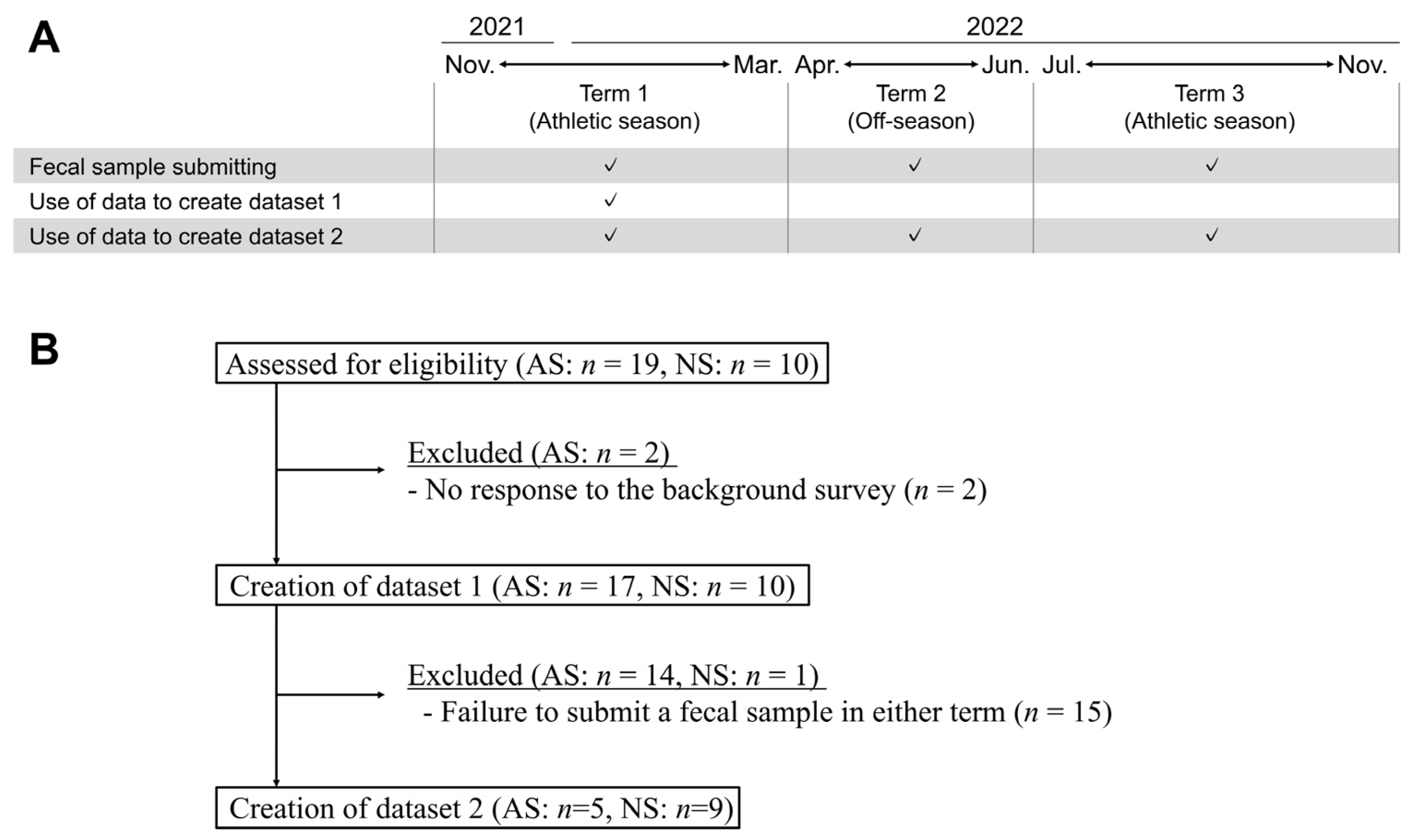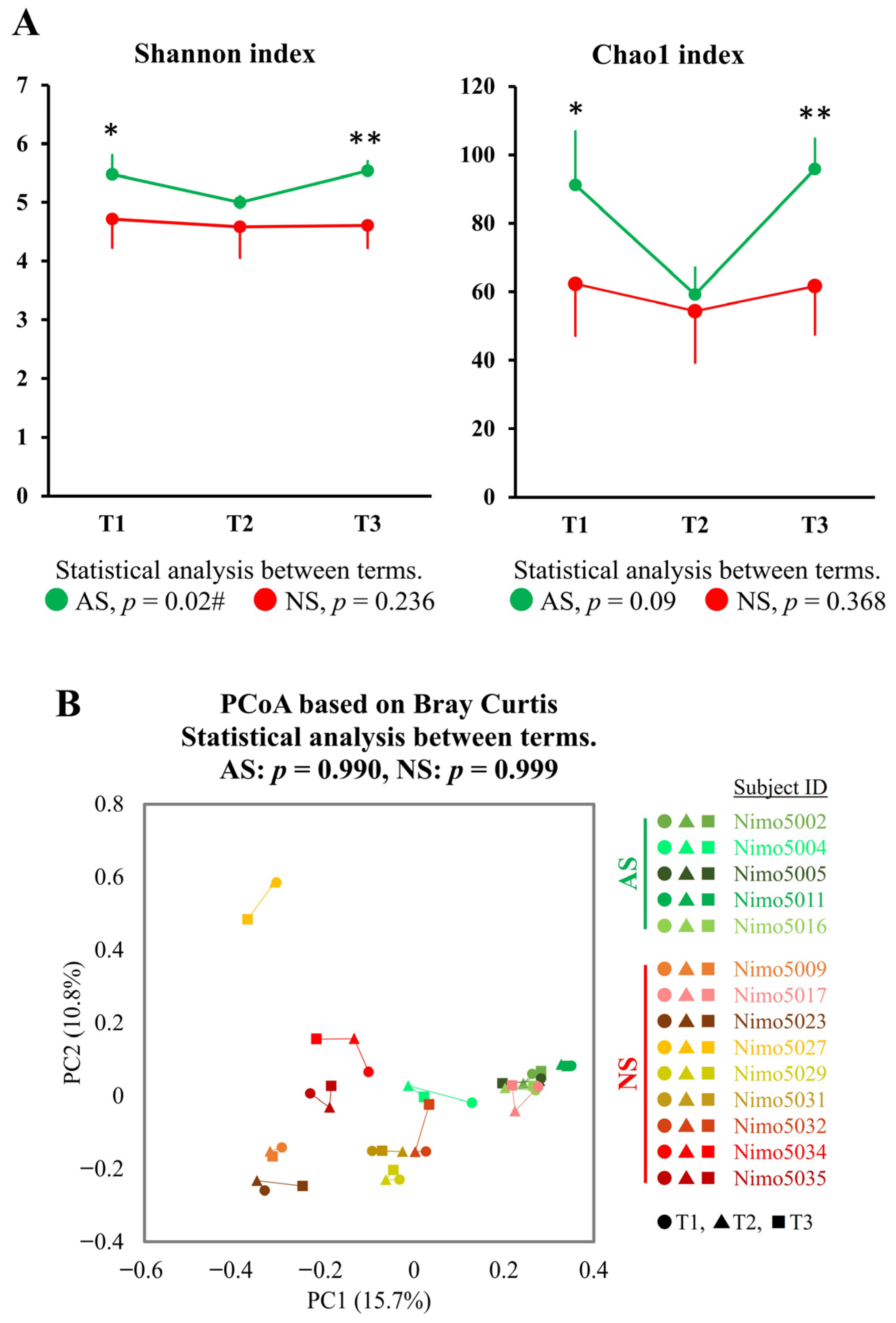An Exploratory Study on Seasonal Variation in the Gut Microbiota of Athletes: Insights from Japanese Handball Players
Abstract
:1. Introduction
2. Materials and Methods
2.1. Dataset Construction
2.2. Data Collection
2.3. Bioinformatics Analysis
2.4. Statistical Analysis
2.5. Data Availability
3. Results
3.1. Description of Subjects and Background Information in Datasets
3.2. Comparative Analysis of Gut Microbiota Diversity and Composition between AS and NS in Dataset 1
3.3. Longitudinal Analysis of Alpha-Diversity in the Gut Microbiota between the Terms in Dataset 2
3.4. Longitudinal Analysis of the Gut Microbiota at the Genus Level between the Terms in Dataset 2
4. Discussion
5. Conclusions
Supplementary Materials
Author Contributions
Funding
Data Availability Statement
Acknowledgments
Conflicts of Interest
References
- Jang, L.; Choi, G.; Kim, S.-W.; Kim, B.; Lee, S.; Park, H. The Combination of Sport and Sport-Specific Diet Is Associated with Characteristics of Gut Microbiota: An Observational Study. J. Int. Soc. Sports Nutr. 2019, 16, 21. [Google Scholar] [CrossRef]
- Boytar, A.N.; Skinner, T.L.; Wallen, R.E.; Jenkins, D.G.; Dekker Nitert, M. The Effect of Exercise Prescription on the Human Gut Microbiota and Comparison between Clinical and Apparently Healthy Populations: A Systematic Review. Nutrients 2023, 15, 1534. [Google Scholar] [CrossRef] [PubMed]
- Mohr, A.E.; Jäger, R.; Carpenter, K.C.; Kerksick, C.M.; Purpura, M.; Townsend, J.R.; West, N.P.; Black, K.; Gleeson, M.; Pyne, D.B.; et al. The Athletic Gut Microbiota. J. Int. Soc. Sports Nutr. 2020, 17, 24. [Google Scholar] [CrossRef] [PubMed]
- Clarke, S.F.; Murphy, E.F.; O’Sullivan, O.; Lucey, A.J.; Humphreys, M.; Hogan, A.; Hayes, P.; O’Reilly, M.; Jeffery, I.B.; Wood-Martin, R.; et al. Exercise and Associated Dietary Extremes Impact on Gut Microbial Diversity. Gut 2014, 63, 1913–1920. [Google Scholar] [CrossRef] [PubMed]
- Han, M.; Yang, K.; Yang, P.; Zhong, C.; Chen, C.; Wang, S.; Lu, Q.; Ning, K. Stratification of Athletes’ Gut Microbiota: The Multifaceted Hubs Associated with Dietary Factors, Physical Characteristics and Performance. Gut Microbes 2020, 12, 1842991. [Google Scholar] [CrossRef] [PubMed]
- Bragina, T.V.; Elizarova, E.V.; Sheveleva, S.A. Intestinal Microbiote of Athletes. Probl. Nutr. 2021, 90, 36–52. [Google Scholar] [CrossRef] [PubMed]
- O’Brien, M.T.; O’Sullivan, O.; Claesson, M.J.; Cotter, P.D. The Athlete Gut Microbiome and Its Relevance to Health and Performance: A Review. Sports Med. 2022, 52, 119–128. [Google Scholar] [CrossRef] [PubMed]
- Estaki, M.; Pither, J.; Baumeister, P.; Little, J.P.; Gill, S.K.; Ghosh, S.; Ahmadi-Vand, Z.; Marsden, K.R.; Gibson, D.L. Cardiorespiratory Fitness as a Predictor of Intestinal Microbial Diversity and Distinct Metagenomic Functions. Microbiome 2016, 4, 42. [Google Scholar] [CrossRef]
- Iwasaka, C.; Nanri, H.; Nakagata, T.; Ohno, H.; Tanisawa, K.; Konishi, K.; Murakami, H.; Hosomi, K.; Park, J.; Yamada, Y.; et al. Association of Skeletal Muscle Function, Quantity, and Quality with Gut Microbiota in Japanese Adults: A Cross-Sectional Study. Geriatr. Gerontol. Int. 2024, 24, 53–60. [Google Scholar] [CrossRef]
- Nishijima, S.; Suda, W.; Oshima, K.; Kim, S.-W.; Hirose, Y.; Morita, H.; Hattori, M. The Gut Microbiome of Healthy Japanese and Its Microbial and Functional Uniqueness. DNA Res. 2016, 23, 125–133. [Google Scholar] [CrossRef]
- Li, Y.; Cheng, M.; Zha, Y.; Yang, K.; Tong, Y.; Wang, S.; Lu, Q.; Ning, K. Gut Microbiota and Inflammation Patterns for Specialized Athletes: A Multi-Cohort Study across Different Types of Sports. mSystems 2023, 8, e0025923. [Google Scholar] [CrossRef] [PubMed]
- Bonomini-Gnutzmann, R.; Plaza-Díaz, J.; Jorquera-Aguilera, C.; Rodríguez-Rodríguez, A.; Rodríguez-Rodríguez, F. Effect of Intensity and Duration of Exercise on Gut Microbiota in Humans: A Systematic Review. Int. J. Environ. Res. Public Health 2022, 19, 9518. [Google Scholar] [CrossRef] [PubMed]
- Park, J.; Kato, K.; Murakami, H.; Hosomi, K.; Tanisawa, K.; Nakagata, T.; Ohno, H.; Konishi, K.; Kawashima, H.; Chen, Y.A.; et al. Comprehensive Analysis of Gut Microbiota of a Healthy Population and Covariates Affecting Microbial Variation in Two Large Japanese Cohorts. BMC Microbiol. 2021, 21, 151. [Google Scholar] [CrossRef] [PubMed]
- Hiraku, A.; Nakata, S.; Murata, M.; Xu, C.; Mutoh, N.; Arai, S.; Odamaki, T.; Iwabuchi, N.; Tanaka, M.; Tsuno, T.; et al. Early Probiotic Supplementation of Healthy Term Infants with Bifidobacterium longum subsp. infantis M-63 Is Safe and Leads to the Development of Bifidobacterium-Predominant Gut Microbiota: A Double-Blind, Placebo-Controlled Trial. Nutrients 2023, 15, 1402. [Google Scholar] [CrossRef]
- Kanda, Y. Investigation of the Freely Available Easy-to-Use Software “EZR” for Medical Statistics. Bone Marrow Transplant. 2013, 48, 452–458. [Google Scholar] [CrossRef] [PubMed]
- Barton, W.; Penney, N.C.; Cronin, O.; Garcia-Perez, I.; Molloy, M.G.; Holmes, E.; Shanahan, F.; Cotter, P.D.; O’Sullivan, O. The Microbiome of Professional Athletes Differs from That of More Sedentary Subjects in Composition and Particularly at the Functional Metabolic Level. Gut 2018, 67, 625–633. [Google Scholar] [CrossRef] [PubMed]
- Akazawa, N.; Nakamura, M.; Eda, N.; Murakami, H.; Nakagata, T.; Nanri, H.; Park, J.; Hosomi, K.; Mizuguchi, K.; Kunisawa, J.; et al. Gut Microbiota Alternation with Training Periodization and Physical Fitness in Japanese Elite Athletes. Front. Sport. Act. Living 2023, 5, 1219345. [Google Scholar] [CrossRef] [PubMed]
- Lin, L.; Decker, C.F. Respiratory Tract Infections in Athletes. Dis. Mon. 2010, 56, 407–413. [Google Scholar] [CrossRef]
- Jama-Kmiecik, A.; Frej-Mądrzak, M.; Sarowska, J.; Choroszy-Król, I. Pathogens Causing Upper Respiratory Tract Infections in Outpatients. Adv. Exp. Med. Biol. 2016, 934, 89–93. [Google Scholar] [CrossRef]
- Viciani, E.; Barone, M.; Bongiovanni, T.; Quercia, S.; Di Gesu, R.; Pasta, G.; Manetti, P.; Iaia, F.M.; Trecroci, A.; Rampelli, S.; et al. Fecal Microbiota Monitoring in Elite Soccer Players Along the 2019-2020 Competitive Season. Int. J. Sports Med. 2022, 43, 1137–1147. [Google Scholar] [CrossRef]
- Bycura, D.; Santos, A.C.; Shiffer, A.; Kyman, S.; Winfree, K.; Sutliffe, J.; Pearson, T.; Sonderegger, D.; Cope, E.; Caporaso, J.G. Impact of Different Exercise Modalities on the Human Gut Microbiome. Sports 2021, 9, 14. [Google Scholar] [CrossRef] [PubMed]
- Ortiz-Alvarez, L.; Xu, H.; Martinez-Tellez, B. Influence of Exercise on the Human Gut Microbiota of Healthy Adults. Clin. Transl. Gastroenterol. 2020, 11, e00126. [Google Scholar] [CrossRef] [PubMed]
- Flint, H.J.; Duncan, S.H.; Scott, K.P.; Louis, P. Links between Diet, Gut Microbiota Composition and Gut Metabolism. Proc. Nutr. Soc. 2015, 74, 13–22. [Google Scholar] [CrossRef] [PubMed]
- Bongiovanni, T.; Yin, M.O.L.; Heaney, L.M. The Athlete and Gut Microbiome: Short-Chain Fatty Acids as Potential Ergogenic Aids for Exercise and Training. Int. J. Sports Med. 2021, 42, 1143–1158. [Google Scholar] [CrossRef]
- Dohnalová, L.; Lundgren, P.; Carty, J.R.E.; Goldstein, N.; Wenski, S.L.; Nanudorn, P.; Thiengmag, S.; Huang, K.-P.; Litichevskiy, L.; Descamps, H.C.; et al. A Microbiome-Dependent Gut–Brain Pathway Regulates Motivation for Exercise. Nature 2022, 612, 739–747. [Google Scholar] [CrossRef]




| AS | NS | p-Values | |||
|---|---|---|---|---|---|
| (n = 17) | (n = 10) | ||||
| Height | cm | 182.6 ± 6.8 | 176.6 ± 7.9 | p = 0.073 | Welch’s t-test |
| Body weight | kg | 87.5 ± 8.4 | 70.6 ± 10.0 | p < 0.01 ** | Welch’s t-test |
| BMI | kg/m2 | 26.2 ± 1.4 | 22.6 ± 2.3 | p < 0.01 ** | Welch’s t-test |
| Age | Twenties | 13 | 4 | p = 0.101 | Fisher’s exact test |
| Thirties | 4 | 6 | |||
| Active time per day (e.g., sports and/or physical labor) | less than 30 min | 0 | 6 | p < 0.01 ** | Fisher’s exact test |
| 30 min–3 h | 12 | 4 | |||
| 3 h or more | 5 | 0 | |||
| Sedentary time per day | less than 3 h | 2 | 1 | p = 0.014 * | Fisher’s exact test |
| 3–8 h | 15 | 5 | |||
| 8 h or more | 0 | 4 | |||
| AS | NS | p-Values | |||
|---|---|---|---|---|---|
| (n = 5) | (n = 9) | ||||
| Height | cm | 185.2 ± 5.5 | 175.6 ± 8.1 | p = 0.022 * | Welch’s t-test |
| Body weight | kg | 90.2 ± 5.8 | 68.7 ± 9.1 | p < 0.01 ** | Welch’s t-test |
| BMI | kg/m2 | 26.3 ± 1.4 | 22.2 ± 2.3 | p < 0.01 ** | Welch’s t-test |
| Age | Twenties | 3 | 3 | p = 0.59 | Fisher’s exact test |
| Thirties | 2 | 5 | |||
| Active time per day (e.g., sports and/or physical labor) | less than 30 min | 0 | 6 | p < 0.01 ** | Fisher’s exact test |
| 30 min–3 h | 2 | 3 | |||
| 3 h or more | 3 | 0 | |||
| Sedentary time per day | less than 3 h | 0 | 1 | p = 0.15 | Fisher’s exact test |
| 3–8 h | 5 | 4 | |||
| 8 h or more | 0 | 4 | |||
Disclaimer/Publisher’s Note: The statements, opinions and data contained in all publications are solely those of the individual author(s) and contributor(s) and not of MDPI and/or the editor(s). MDPI and/or the editor(s) disclaim responsibility for any injury to people or property resulting from any ideas, methods, instructions or products referred to in the content. |
© 2024 by the authors. Licensee MDPI, Basel, Switzerland. This article is an open access article distributed under the terms and conditions of the Creative Commons Attribution (CC BY) license (https://creativecommons.org/licenses/by/4.0/).
Share and Cite
Toda, K.; Yoshimoto, S.; Yoshida, K.; Mitsuyama, E.; Iwabuchi, N.; Hosomi, K.; Sanada, T.J.; Tanaka, M.; Nanri, H.; Kunisawa, J.; et al. An Exploratory Study on Seasonal Variation in the Gut Microbiota of Athletes: Insights from Japanese Handball Players. Microorganisms 2024, 12, 781. https://doi.org/10.3390/microorganisms12040781
Toda K, Yoshimoto S, Yoshida K, Mitsuyama E, Iwabuchi N, Hosomi K, Sanada TJ, Tanaka M, Nanri H, Kunisawa J, et al. An Exploratory Study on Seasonal Variation in the Gut Microbiota of Athletes: Insights from Japanese Handball Players. Microorganisms. 2024; 12(4):781. https://doi.org/10.3390/microorganisms12040781
Chicago/Turabian StyleToda, Kazuya, Shin Yoshimoto, Keisuke Yoshida, Eri Mitsuyama, Noriyuki Iwabuchi, Koji Hosomi, Takayuki Jujo Sanada, Miyuki Tanaka, Hinako Nanri, Jun Kunisawa, and et al. 2024. "An Exploratory Study on Seasonal Variation in the Gut Microbiota of Athletes: Insights from Japanese Handball Players" Microorganisms 12, no. 4: 781. https://doi.org/10.3390/microorganisms12040781
APA StyleToda, K., Yoshimoto, S., Yoshida, K., Mitsuyama, E., Iwabuchi, N., Hosomi, K., Sanada, T. J., Tanaka, M., Nanri, H., Kunisawa, J., Odamaki, T., & Miyachi, M. (2024). An Exploratory Study on Seasonal Variation in the Gut Microbiota of Athletes: Insights from Japanese Handball Players. Microorganisms, 12(4), 781. https://doi.org/10.3390/microorganisms12040781






